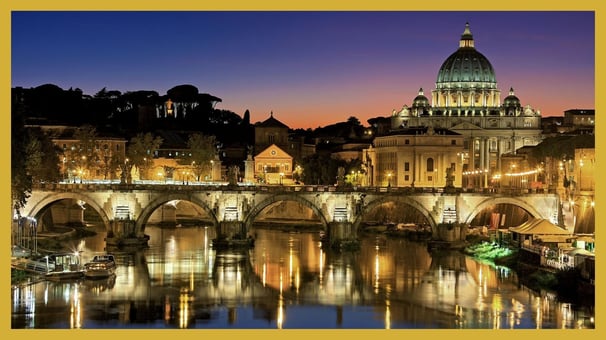Guided Walks and Paths for Pilgrims in Rome: 2025 Jubilee
Contents
From Piazza Venezia to the Pantheon
From Campo de' Fiori to Piazza Navona
Along Via del Corso
From Castel Sant'Angelo to St. Peter's
Conclusion
Roma, la Città Eterna, è la destinazione ideale per i pellegrini, soprattutto in occasione del Giubileo 2025. Le sue strade intrise di storia e spiritualità offrono l'opportunità di vivere un'esperienza unica di fede e cultura. Attraversare Roma durante il Giubileo significa immergersi in un percorso di devozione e meraviglia artistica, esplorando i luoghi simbolo della cristianità e della storia romana. Ogni angolo della città racchiude secoli di storia e arte, rendendo Roma un museo a cielo aperto che invita i visitatori a scoprire la profondità della fede cattolica attraverso la sua architettura, le sue piazze e le sue chiese. Ecco alcuni itinerari per i pellegrini che vogliono scoprire la città sotto una luce nuova.


From Piazza Venezia to the Pantheon (1,5 km)
This itinerary invites you to explore some of the most iconic squares and churches in Rome, offering a spiritual journey enriched by artistic splendor. Walking through these revered spaces melds a pilgrimage with the awe of witnessing historical treasures. Each stop invites reflection and an appreciation for the magnificence of Christian traditions, set against the backdrop of the capital’s grandeur.
This itinerary takes you through some of Rome's most iconic piazzas, with stops at churches of great historical and artistic value.
Piazza Venezia: Your journey begins at Piazza Venezia, where you find the majestic Vittoriano, a monument dedicated to Victor Emmanuel II. This imposing structure is not only a symbol of Italian unity but also stands as a significant landmark for understanding the complex history and evolution of Rome over the centuries.
Chiesa di Sant'Ignazio di Loyola: As you proceed, you will come upon the breathtaking Church of St. Ignatius of Loyola, renowned for the fresco The Triumph of the Name of Jesus by Giovanni Battista Gaulli, a masterpiece of perspective. The church’s illusive dome is among the most striking examples of how Baroque art can produce stunning visual effects, instilling a sense of both majesty and infinity.
Basilica di Santa Maria sopra Minerva: This site is a rare example of Gothic architecture in Rome, housing the tomb of Saint Catherine of Siena and a statue of the Risen Christ by Michelangelo. The basilica is a unique blend of Gothic and Renaissance elements, providing pilgrims an enriching experience of both spiritual and artistic beauty.
San Luigi dei Francesi: Here, you can marvel at the esteemed Caravaggio paintings dedicated to Saint Matthew. Caravaggio's works in this church are celebrated for their realism and innovative use of light, which vividly captures the dramatic essence of these sacred episodes.
Basilica di Sant'Agostino in Campo Marzio: This basilica contains masterpieces by Caravaggio and a fresco by Raphael, showcasing the artistic and spiritual wealth of the church and reflecting the profound intersection of faith and art.
This itinerary is a voyage into the heart of Rome, blending history, art, and faith, offering pilgrims an experience of profound spirituality. Each stop strengthens the connection between the visitor and the Christian tradition: from the grandeur of the Vittoriano to the spirituality of the churches, every site enriches the pilgrimage with meaning and beauty. The itinerary not only allows for the admiration of artistic masterpieces but also provides insight into how history and faith are intricately woven into the fabric of the city..
From Campo de' Fiori to Piazza Navona (1 km)
Begin your pilgrimage at Campo de' Fiori, a bustling square that boasts a rich historical tapestry, symbolized by the enigmatic statue of Giordano Bruno, a martyr for intellectual freedom. This vibrant space once hosted dramatic episodes of history and today serves as a profound starting point that blends spirituality with the architectural grandeur of Rome. The square, alive with the daily hum of locals and tourists alike, sets the stage for an unforgettable journey through Roman spirituality and architecture.
Walk through the historic center of Rome, discovering churches and squares of great religious and architectural importance.
Campo de' Fiori: Where the past and present merge vividly, marked by the statue of Giordano Bruno. This lively square is more than a marketplace; it is a reminder of the eternal struggle for truth and freedom.
Basilica di Sant'Andrea della Valle: Step inside to witness the second-highest dome in Rome, a marvel of Baroque architecture that captivates visitors with its elaborate ornamental designs and breathtaking scale. Known also as the setting for the first act of Puccini's Tosca, this basilica offers a spellbinding example of spiritual and artistic grandeur.
Sant'Ivo alla Sapienza: Designed by the ingenious Francesco Borromini, this architectural gem showcases fascinating perspective games and a unique design. While access to its interior might be limited, the external view alone sparks wonder, embodying Borromini's bold architectural spirit.
Sant'Agnese in Agone: Overlooking Piazza Navona, this stunning Baroque church is another masterpiece by Borromini. Its facade complements the vibrant life of the square, harmoniously blending sacred architecture into the bustling urban environment. The church invites you to appreciate the serene yet intricate beauty of Baroque art and spirituality.
This route through Baroque Rome is not just a walking tour; it is an immersive experience into the architectural splendor and spiritual depth of the Eternal City. Each church and square narrates part of Rome’s rich baroque tale, evoking a sense of the divine through spectacular artistry.
Along Via del Corso (2 km)
Travel along Via del Corso, a vital artery that connects Piazza del Popolo with Piazza Venezia, threading through the heart of Rome. This path links landmarks of immense historical, artistic, and religious significance, offering a unique glimpse into the city's urban and cultural evolution.
Piazza del Popolo: Begin at the Basilica of Santa Maria del Popolo, which guards treasures by Caravaggio and Annibale Carracci. This basilica is a veritable treasure chest of Renaissance and Baroque art, highlighted by the Cerasi Chapel, home to some of Caravaggio’s most celebrated masterpieces, drawing admirers into a world of sublime artistry and historical depth.
Chiesa di San Lorenzo in Lucina: Featuring a precious painted cross in its chapel. This church, albeit lesser-known, creates a serene atmosphere and a sense of peace that invites reflection.
Sant'Andrea al Quirinale: A Bernini design, renowned for its oval layout and groundbreaking architecture. Inside, the warm hues and diffused lighting foster an intimate and spiritual setting that showcases Bernini’s genius in blending art with faith.
Santa Maria della Vittoria: Home to Bernini's Ecstasy of Saint Teresa, a celebrated masterpiece. This sculpture epitomizes the zenith of the Baroque, where art becomes a vessel for conveying mystical ecstasy and intense devotion.
This route offers a chance to discover the less apparent yet strikingly beautiful artistic treasures of the city. Via del Corso Street, steeped in history and dotted with churches, is a nexus where the sacred and secular converge, presenting pilgrims a devout passage through the vibrant heart of Rome.
From Castel Sant'Angelo to St. Peter's (1 km)
This itinerary traverses some of Rome's most emblematic sites, deeply entrenched in Christian tradition. It represents one of the most poignant pilgrimages, symbolically linking the temporal power of the popes with the epicenter of Christianity.
Castel Sant'Angelo: Originally Emperor Hadrian’s mausoleum, later transformed into a papal fortress. This site boasts a rich and complex history, mirroring Rome’s transformations from an imperial burial site to a papal sanctuary.
Chiesa di Santa Maria in Vallicella (Chiesa Nuova): Home to Rubens' Madonna della Vallicella. This church is a bastion of spirituality, where art and faith merge to provide a unique contemplative experience. It is traditionally the starting point for The Seven Churches Pilgrimage.
St. Peter's Basilica: The heart of Catholic Christianity, housing masterpieces such as Michelangelo’s Pietà and Bernini's Baldachin. St. Peter's Square, with its embracing colonnades, signifies the Church’s welcoming embrace to all the faithful.
This journey culminates in St. Peter’s Square, a pivotal site for the Jubilee, symbolizing a pilgrimage at the heart of the faithful's devotion. Each step along this route is laden with meaning, guiding pilgrims toward the core of Christianity, where some of the grandest masterpieces of sacred art can be admired.
Conclusion
The proposed routes offer not only a profound spiritual experience for the pilgrims of the 2025 Jubilee but also lead through Rome's incredible wealth of art and history. Each itinerary provides a unique perspective on the city’s spiritual and artistic heritage, complementing one another to give a holistic view of the beauty and faith defining the Eternal City. Exploring Rome is to live faith with every step, encountering monuments and churches that tell the tales of Christianity and art. Each route invites one to rediscover Rome as a sphere of devotion, beauty, and inspiration, where past and present converge to offer pilgrims an experience of faith that transcends ordinary tourism, becoming a genuine spiritual passage through art and history. Each step, each pause, each church visited presents a chance to come closer to the divine, rediscovering the profound meanings of faith and the pervasive beauty across this remarkable city
Drop us a line
Follow us
Discover the Jubilee
Experience the Jubilee
Jubilee locations
Get ready for the Jubilee
Rome and the Jubilee
